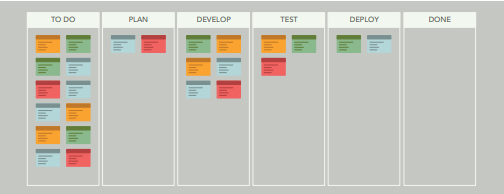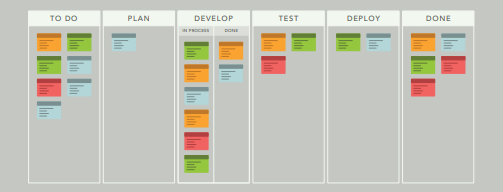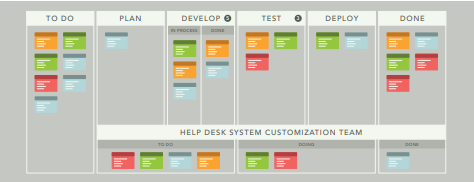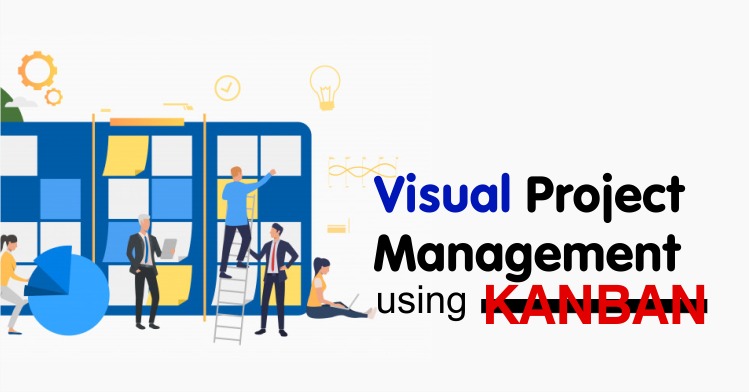Kanban is a way of thinking about and managing work that can bring discipline and focus on the way your team works. Kanban provides that clarity through this one concept: Visualize your workflow. Visualizing your workflow might sound like an overly simplistic solution, but it can truly work wonders on your team’s ability to work with clarity and purpose. By encouraging teams to identify, prioritize, and intentionally complete work items one at a time, Kanban can help combat the damaging effects of multitasking in a hyper-stimulated world. You do this by figuring out upfront what steps need to be taken on a piece of work and then doing them in that order. Sounds simple, right? But most of our processes are far from linear.
Think about the last project you completed, and the process it went through to go from To Do to Done – was it linear? Did it move smoothly through your process, or did it stop and start and backtrack? Did you finish it on time, or did it take you longer than expected?
Visualizing your workflow will help you define the steps in your team’s process, and refine your process steps to continue to cut out wasted effort, time, and activity.
KANBAN BOARDS AND CARDS
Now that you know the what of Kanban, let’s discuss the how. Kanban uses boards – Kanban boards – to represent your process, and cards to represent your work items. Every Kanban board reflects some version of this basic workflow: To do > Doing > Done
The first step to practising Kanban is to customize your board to accurately reflect your unique process. Here are some examples of different Kanban boards for a Marketing team, an IT operations team, and an HR department.
Marketing | Backlog > Planning/Research > Testing > Implementation > Analysis > Done
IT Operations | Incoming Request > Ready > In-Flight > Delivered
HR | To Do > Planning > Doing > Reviewing > Done
Then, you’ll want to populate your board with cards. Kanban cards represent tasks and serve as visual reminders
of what needs to get done, that you can physically move through your process as you go
FOUR PRINCIPLES OF KANBAN
A Kanban board gives a real-time snapshot of backlog and work in progress, making it easy to decipher what work needs to be done and when. While anyone can visualize tasks on a board, your team isn’t really practising Kanban unless you’re following these four principles.
Visualize All Work
In order to visualize work, a team must first map out their workflow and break it down into its core stages. Each lane in a Kanban board is then configured to match those stages or handoffs. As work items are initiated, they are made into cards and placed in the appropriate lane. By making the workflow visible in this way, teams can observe the flow of work as well as who is working on what. This visibility alone leads to increased communication and collaboration among team members. Mapping your process as a team is an important step in getting started with Kanban, with as a team being the key phrase. Working collaboratively with everyone on your team to define your process will help to ensure that the workflow you decide to map out on your Kanban board accurately reflects the way your team works. You might be surprised by how much you’ll learn about your process!

Focus On Flow
In addition to limiting work in progress, Kanban allows teams to focus on process flow in a more visual manner. Being able to see the process in action allows teams to identify elements of the process that may have gone unnoticed without the visual representation. For example, by assigning each card to a team member, managers can see who on the team is working at capacity and who could take on more work items. Other team members can also see who may need help with work items at any given time. They can also see where projects are getting held up in the process so that inefficiencies can be identified, and work together to regain a healthy flow of work through the system.

Limiting Work In Progress
One of the benefits of increased visibility, as discussed above, is having one shared view of work in progress. When teams have too many items in the Work in Process (WIP) lane, it can lead to task switching, which causes people to lose focus and confuse prioritization. Without a system to prioritize one task over another, everything feels urgent – making you far more likely to engage in multitasking. All too often, we feel as though we have to be available at all times so that we don’t miss anything – we have to have Slack notifications, email notifications, etc. that follow us everywhere we go. Kanban can help us to minimize distractions by providing a system by which we can prioritize work. When an unplanned work request comes in, as a team, you can look at your board and say, “We’re working on finishing task A right now, but then we will have capacity to help you with task B. We will reach out to you when we are ready to help with task B.” By simply implementing a limit to the amount of work in progress at any given time, you can reduce the time it takes for a work item to move through your team’s process. Furthermore, teams and managers can easily identify bottlenecks and queues that may be slowing down the process or preventing the team from working as efficiently as possible. Not only can this improve the quality of the end product, but it can help teams save significant time and resources overall.

Practice Continuous Improvement
Yes – it’s true that the goal of continuous improvement is to help teams improve, continuously. But in the context of Kanban, continuous improvement is far more than that. It refers to the operationalization of improvement activity within an organization: The shared mindset and set of practices that, when done consistently, promote data-driven analysis and effective process improvement, and encourage innovation and growth across the organization. This doesn’t happen on day one of practicing Kanban – it’s the product of Kanban maturity. In order to practice true continuous improvement, organizations need to first master other key elements of Kanban: Namely, increasing visibility, actively managing flow, and using Lean metrics to measure your progress. Through these steps, you can unlock the power of continuous improvement.


